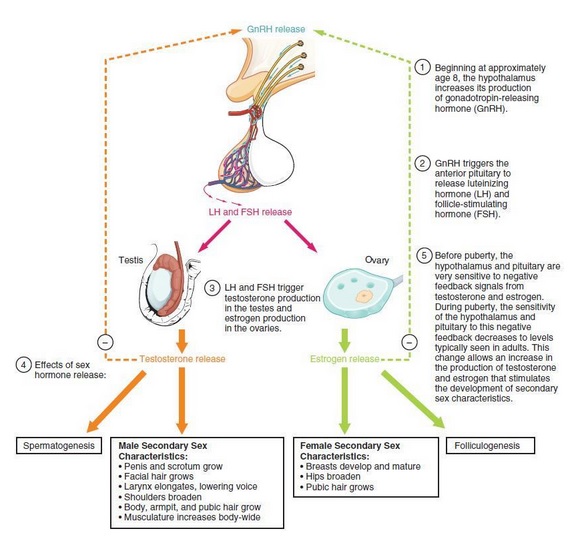13.3 Development of the Female Reproductive System
Learning Objectives
By the end of this section, you will be able to:
- Explain how bipotential tissues are directed to develop into female sex organs.
- Name the rudimentary duct systems in the embryo that are precursors to female internal sex organs.
- Describe the hormonal changes that bring about puberty and the secondary sex characteristics.
The development of the reproductive systems begins soon after fertilization of the egg, with primordial gonads beginning to develop approximately one month after conception. Reproductive development continues in utero, but there is little change in the reproductive system between infancy and puberty.
Development of the Sexual Organs in the Embryo and Fetus
Recall the discussion regarding the development of male sex organs in Chapter 12. The discussion will continue here, focusing on female development.
Without appropriate chemical signaling, all fertilized eggs would develop into females. As discussed in Chapter 12, the presence of the SRY gene on the Y chromosome is required for male development. Since females do not have a Y chromosome, they do not have the SRY gene. Without a functional SRY gene, an individual will be female.
The presence of bipotential tissue in embryos necessitates appropriate signaling to determine whether these tissues develop into characteristic male or female structures. Without SRY, oogonia form, and primordial follicles develop in the primitive ovary. Hormones also influence the development of sex characteristics. Indeed, the absence of testosterone triggers the development of the glans clitoris as opposed to the glans penis.
Regarding structures that do not develop from bipotential tissues, a set of ducts must properly develop to give rise to the appropriate structures (i.e., uterus, uterine tubes, and part of the vagina in females). In females, the absence of sustentacular cells results in a lack of secretions that would normally degrade the female tract, or Müllerian duct. Additionally, the absence of testosterone prevents the growth of the male tract, or Wolffian duct. Given the lack of triggers for male development, the Müllerian duct grows, and the Wolffian duct is degraded, resulting in the proper development of female reproductive structures and appropriate reproductive functioning in adulthood.
Interactive Link
Recall this animation (https://www.babycenter.com/pregnancy/your-baby/inside-pregnancy-girl-or-boy_10313041#videoplaylist) from Chapter 12 to see a comparison of the development of structures of the female and male reproductive systems in a growing fetus.
Further Sexual Development Occurs at Puberty
Recall Figure 12.9 as we focus on the hormonal regulation of maturation and the development of secondary sex characteristics in the female reproductive system. As females approach puberty, the ovaries become enlarged and undergo maturation, causing higher blood concentrations of sex hormones and stimulating folliculogenesis.
In addition to age, multiple factors can affect the age of onset of puberty, including genetics, environment, and psychological stress. One of the more important influences may be nutrition; historical data demonstrate the effect of better and more consistent nutrition on the age of menarche in the United States, which decreased from an average age of approximately 17 years of age in 1860 to the current age of approximately 12.75 years in 1960, as it remains today. Some studies indicate a link between puberty onset and the amount of stored fat in an individual. This effect is more pronounced in females but has been documented in both sexes. Body fat, corresponding with the secretion of the hormone leptin by adipose cells, appears to have a strong role in determining menarche. This may reflect, to some extent, the high metabolic costs of gestation and lactation. In females who are extremely lean and highly active, such as gymnasts, there is often a delay in the onset of puberty.

Signs of Puberty
Review Table 13.1 for a list of secondary sexual characteristics as determined by sex steroid hormone concentrations in the female.

As a female reaches puberty, typically, the first visible change is the development of breast tissue. This is followed by the growth of axillary and pubic hair. A growth spurt normally starts at approximately age 9 to 11 and may last two years or more. During this time, height can increase 3 inches a year. The next step in puberty is menarche, the start of menstruation.
